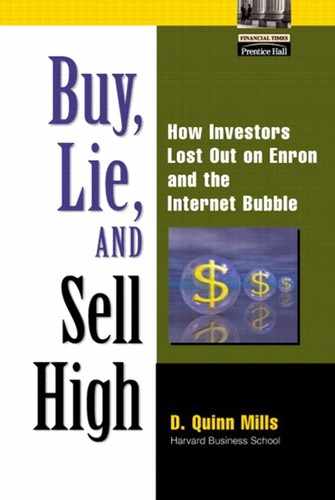Who Brought Those Duds to Market?
In an article entitled “Just Who Brought Those Duds to Market?” The New York Times wrote:
… many Wall Street investment banks, from top-tier firms like Goldman Sachs … to newer entrants like Thomas Weisel Partners … have reason to blush… Of course, investment banks that took these under-performing companies public may not care. They bagged enormous fees, a total of more than $600 million directly related to initial public offerings involving just the companies whose stocks are now under $1.
… How did investment banks, paid for their expert advice, pick such lemons?[59]
Part of the answer is that investment banks seem to have assigned dot-coms to analysts who specialized in technology companies. But as we've pointed out before, most dot-coms were not technology companies but marketing companies. The technology analysts didn't understand the dot-com's business models, nor their costs, nor their business prospects. It was as if the investment banks had sent their railway analysts to cover biotechnology companies. If this had happened and investors had known about it, they would have asked themselves, “What do these guys know?” and answered themselves, “Nothing.” They'd have panicked and sold the biotech companies' stocks.
But for at least three years, the investment banks had the wrong analysts covering Internet stocks—technology analysts covering marketing companies—and no one seemed to realize this or understand it. During the period at a conference I attended, a professional in the financial markets commented to several people, “The day Amazon.com gets covered by a retail analyst is the day its stock will start to go down.”
This question about how investment banks picked lemons to take to the public market became much more commonplace as the bubble burst. “Sudden declines in financial asset prices,” wrote Wall Street guru Henry Kaufmann, “often are precipitated by new data that calls into question the original analysis on which the decision to invest was grounded. What investors then do is think probabilistically: If such and such… is in worse shape than we thought when we got in, maybe others… might also be facing similar problems… They set off a chain of selling…”[60]
Privately, some bankers now admit that they took companies public too soon. Most, however, say that they have always been careful with IPOs, and if they're tightening their underwriting standards now, it's because investors insist they do so. Michael Christenson, head of technology investment banking at Salomon Smith Barney, says IPO candidates today need to have at least $10 million in quarterly revenues, and must be no more than two quarters away from profitability. “We've always strived for high quality,” he says. “What has clearly changed is that we've adjusted our screen for the market.”[61]
So the banks took companies public too quickly. Perhaps the biggest fiasco was pet-food retailer Pets.com, Inc., which took a mere 10 months to go from its $66 million initial public offering to closing its doors. Merrill Lynch took in fees of about $4.6 million for managing the books for the pet-food retailer's stock offering, according to estimates from Thomson Financial. “We had pressure from bankers to go public three months after inception,” says Julie L. Wainwright, the former chief executive of Pets.com.[62]
Henry Blodget, 35, of Merrill Lynch, became famous in 1998 when he predicted that Amazon.com's stock price would reach $400 (it was at $240 at that point), which it did. Unfortunately, he also predicted, through reports and television interviews, that companies such as eToys andPets.com would soar. They never reached profitability, and their stocks never soared. On October 17, 2001, Blodget lowered his short-term rating on Amazon.com to “neutral” from “accumulate”—meaning he expected it to rise less than 10 percent.” It was the beginning of the end, and Blodget left Merrill in November of 2001 to write a book about the Internet bubble. He also left with $2 million that many feel should have been used to compensate some of the investors he misled.[63]
In December 2001, the New York State Attorney General's office announced that Blodget was among a number of Wall Street analysts being investigated for conflicts of interest they may have had while making stock recommendations.[64]
While taking public hundreds of Net companies that have proved to be losers, investment bankers took in $2.1 billion in underwriting fees since 1997, according to Thomson Financial.[65]
Peter Elstrom of Business Week asked a representative of Merrill Lynch about the $100 million in fees Merrill had pulled in since 1997 for taking Internet companies public. The representative defended his company's track record. “Investors wanted these stocks,” he told Elstrom. “It's tough to tell a CEO, 'We won't take you public' when investors are shouting, 'Bring it on!'”
And Elstrom took the point: “Investment bankers took their cash up front, grabbing a slice of the dough raised in IPOs. If the stock cratered, they already had their money in the bank. Venture capitalists had a similar spot in the food chain. In exchange for footing the early costs of a start-up, they got their stock for as little as pennies a share. Even if shares dove after the offering, they were still ahead. And that's the way it has worked for decades.”[66]
